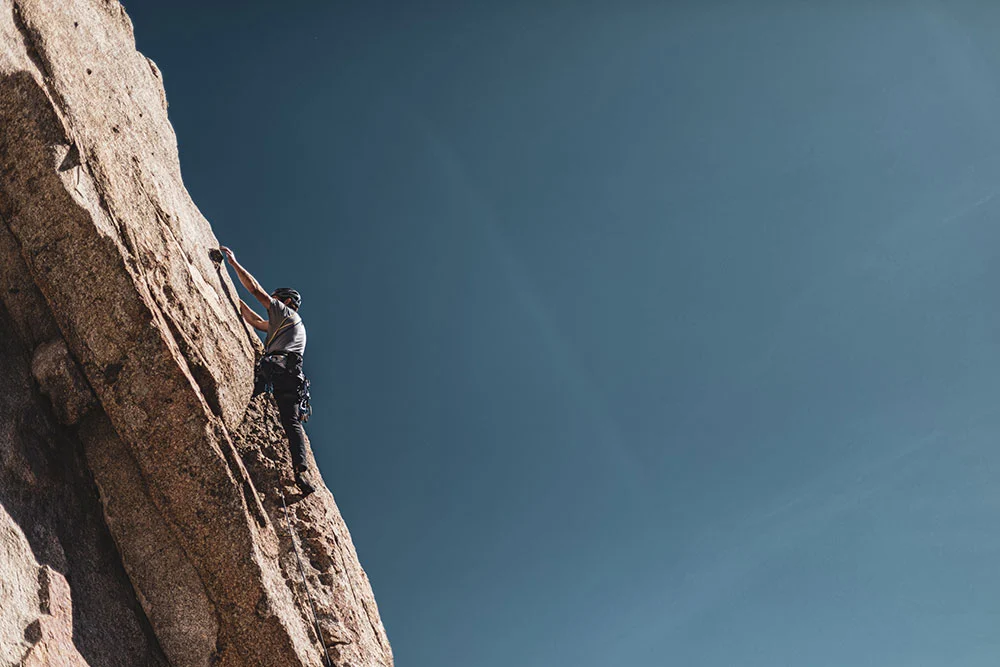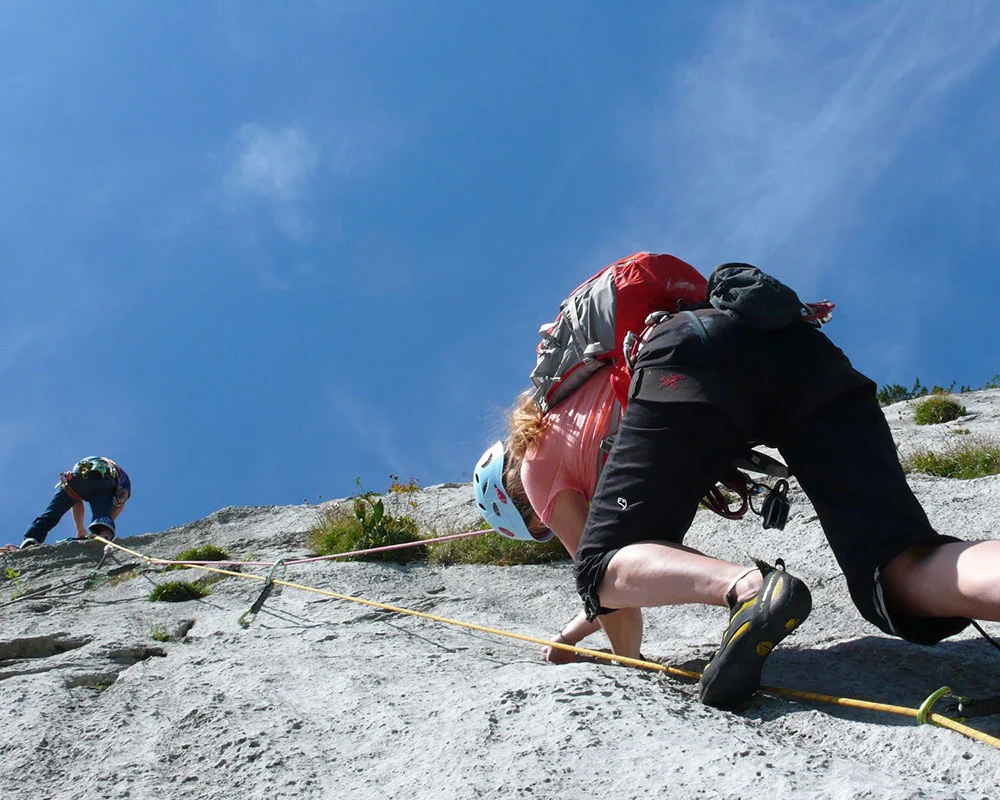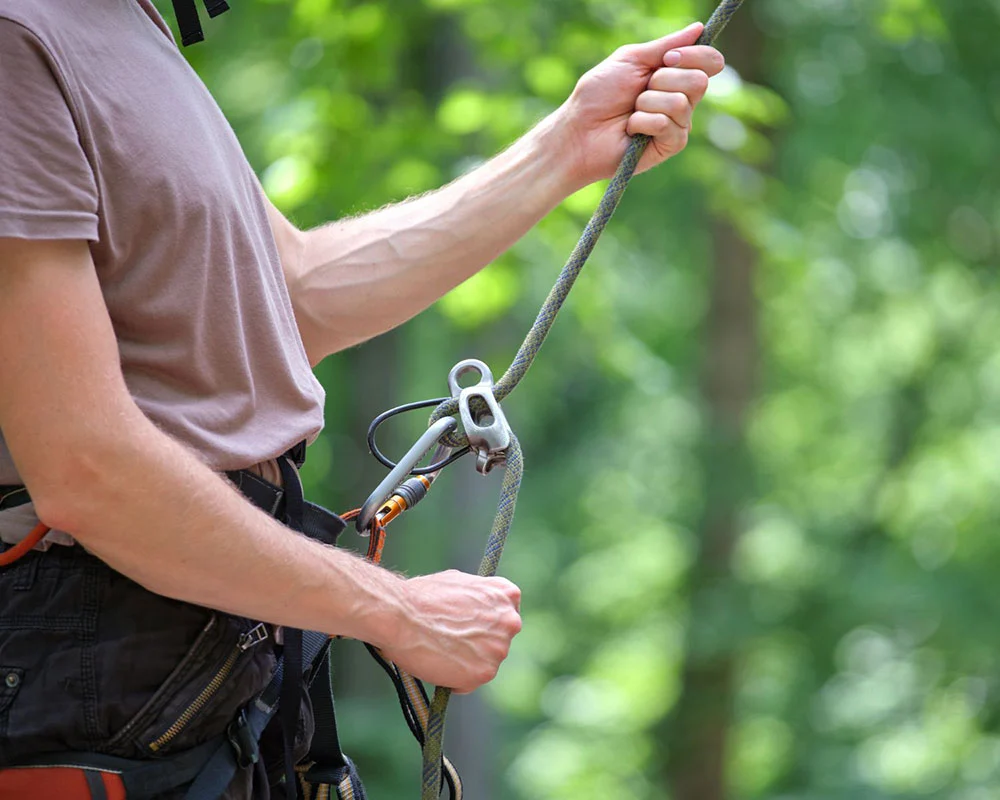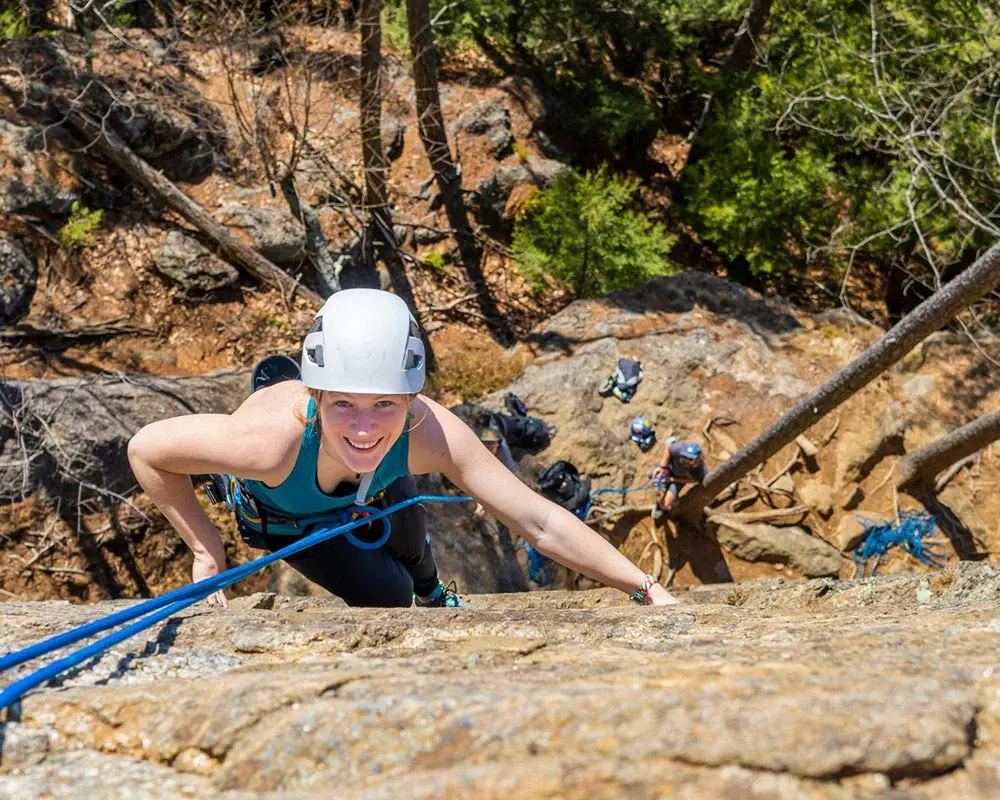Embarking on the thrilling world of trad climbing is an exhilarating experience that combines adventure, skill, and mental fortitude. As a beginner rock climber, it’s essential to understand the unique aspects of this challenging form of climbing and how it differs from sport climbing, aid climbing, and other techniques.
This comprehensive guide will introduce you to the fundamentals of trad climbing – from its history and distinctive features to essential tips for getting started with proper gear selection and mastering crucial skills.
Key Takeaways
- Trad climbing involves placing removable protection devices into cracks and features in the rock instead of clipping into pre-placed bolts like sport climbing.
- It’s essential to have a solid foundation in basic climbing skills and safety precautions, plan ahead, and bring plenty of gear.
- Basic skills include learning proper belay techniques, understanding how to read a route, and mastering different types of holds such as cracks, edges, or pockets.
- Safety measures encompass wearing a helmet at all times and checking gear before each climb.
What Is Trad Climbing?
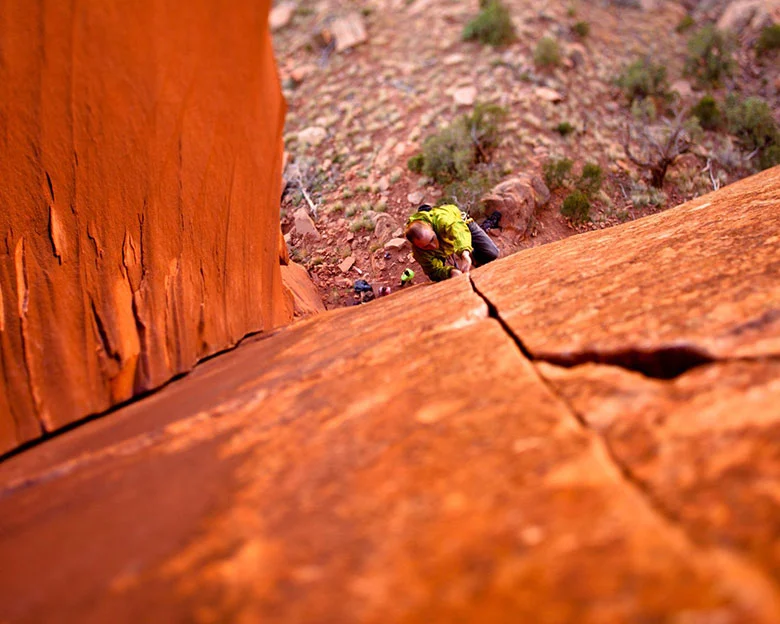
Trad climbing (short for traditional climbing) is one of the oldest styles of rock climbing.
In a Trad climb, the lead climber places removable protection, such as cams and nuts, into cracks and other features in the rock to protect themselves from falls. The lead climber places the removable protection in cracks and other natural features as he climbs. Once the leader reaches a stopping point, often a ledge or the top of the cliff, they secure themselves and belay the second climber, who removes (‘cleans’) the gear from the route.
The most crucial position in trad climbing is the leader, who must be very experienced and skilled in securely placing the types of protective gear so all of the climbers in the group will be protected.
This style of climbing is often seen as more challenging and adventurous due to the greater level of self-reliance and route-finding skills required.
How Does Trad Climbing Differ From Other Types Of Climbing?
Trad climbing is a unique rock climbing sport emphasizing self-reliance, and adventure. Unlike sport climbing or bouldering, where pre-placed bolts are the norm, trad climbers are responsible for placing their own protection as they ascend the rock face. This involves using specialized gear like nuts and cams placed into cracks or other natural features, providing safety without permanently altering the rock.
In addition to the differences in gear, trad climbers must face the mental challenge of making quick decisions about gear placement, route finding, and risk assessment. Trad climbing demands a well-rounded skill set that combines physical prowess, mental fortitude, and deep knowledge of gear and safety systems. This contrasts with sport climbing, where the focus lies predominantly on physical strength and technique, and bouldering, which is characterized by shorter, high-intensity problems.
This handy table compares the 4 main types of rock climbing:
| Characteristics | Trad Climbing | Sport Climbing | Bouldering | Top-Rope Climbing |
| Protection | Climber places removable protection | Pre-placed bolts on route | No protection, crash pads for safety | Anchors set up at the top of the climb |
| Route Length | Can range from single to multi-pitch | Typically single-pitch routes | Short, intense problems | Single-pitch routes |
| Mental Challenge | High (route finding, gear placement) | Moderate (focus on strength) | Low to moderate (problem-solving) | Low (minimal risk involved) |
| Physical Challenge | Moderate to high | High (emphasis on strength) | High (powerful moves, strength) | Moderate (focus on technique) |
| Gear Required | Nuts, cams, slings, quickdraws | Quickdraws, harness, rope | Climbing shoes, chalk, crash pad | Harness, rope, belay device, anchor set |
| Impact on Rock Surface | Minimal, removable protection | Bolts permanently placed in rock | Minimal, natural features used | Minimal, anchors placed at top |
| Climbing Experience | Adventure, self-reliance | Focus on strength, endurance | Emphasis on strength, problem-solving | Learning, safety, technique practice |
Trad climbers require excellent balance control skills along with mental calmness when placing gear and building anchors during ascent or descent.
Lastly, unlike sport or indoor climbing walls, where climbs are designed explicitly for people who want easy access; traditional routes are almost always unpredictable due to changing environments, including the type and condition of the rock, changes due to erosion or other factors, and changing weather conditions. These challenges give trad climbers endless possibilities and provide unexpected situations that make each climb a one-of-a-kind experience!
Check out this video for a comprehensive understanding of the various types of rock climbing.
You will also find it helpful to read our comprehensive guide to understanding the different types of rock climbing. This guide provides an in-depth overview of each type of climbing and can assist you in selecting the best fit for your needs.
The Challenge And Adventure Of Trad Climbing
Trad climbing is an incredibly challenging and adventurous discipline requiring a unique skill set.
One of the biggest challenges of trad climbing is placing gear while on lead. The lead climber must have superior climbing skills to maintain balance while carefully evaluating each placement opportunity and placing the necessary anchors.
The adventure aspect of trad climbing comes not just from mastering the necessary climbing techniques but also from being able to explore remote areas and finding new routes up unclimbed peaks. Modern trad climbing focuses on ascending free-climbing routes using only natural features like cracks and flakes – like those found along Yosemite Valley’s iconic granite walls.
Getting Started With Trad Climbing

Before you begin trad climbing, you need to have a solid foundation in basic climbing skills and safety precautions. This includes learning proper belay techniques, understanding how to read a route, and mastering different types of holds, such as cracks, edges, and pockets.
When preparing for your first trad climb, it’s crucial to go with a more experienced climber, plan ahead and bring plenty of gear. How much gear you need usually depends on the difficulty level of the climb.
Overall, trad climbing requires physical endurance and mental fortitude, so don’t get discouraged by setbacks but be cautious. If there’s any doubt about something being safe, make sure everything is double-checked before committing!
Getting started with trad climbing can be challenging – but very rewarding – especially when combined with beautiful scenery or tackling perfect lines on stunning rock faces like those found at Red Rock Canyon outside Las Vegas, USA, where much hard work has been put into establishing excellent quality climbs across all grades incorporating every type of skill.
Tips And Techniques For New Climbers
New climbers should focus on mastering basic climbing skills and safety precautions, understanding climbing grades and ratings, and learning the difference between single-pitch and multi-pitch climbs.
Basic Climbing Skills And Safety Precautions
Before you start trad climbing, it’s essential to have some basic skills and knowledge of safety precautions. Here are some tips for beginner rock climbers:
1. Always wear a helmet to protect your head from falling rocks or other debris.
2. Learn proper belaying techniques and knots and how to anchor yourself to the wall.
3. Take a class or hire a guide to learn basic climbing techniques such as footwork, balance, and body positioning.
4. Check your gear before each climb to make sure it’s secure and in good condition.
5. Start with easier routes that are within your ability level to build up experience and confidence.
6. Never climb alone; always have a partner to belay you and provide assistance if needed.
7. Be aware of weather conditions and avoid climbing in adverse conditions like high winds or thunderstorms.
8. Communicate clearly with your climbing partner about what you’re doing at all times, especially when setting up anchors or moving between pitches.
Remember that safety is the first priority when trad climbing, so be sure to take all necessary precautions before starting out on any climb.
Check out even more great tips for beginner rock climbers.
Understanding Climbing Grades And Ratings
As you embark on your journey into the world of climbing, it’s essential to understand the various grading systems used to measure the difficulty of climbing routes to help you compare routes, choose routes suitable to your skill level, and track your improvement over time.
The Yosemite Decimal System (commonly referred to as the “YDS”) is a grading system for hiking, scrambling, and rock climbing. While it is primarily used in the U.S., you can find YDS grades all around the world. The YDS is based on a simple scale from 5.0 – 5.15, with each number representing an increase in difficulty level. For example, 5.0 signifies easier climbs with large holds, while 5.15 encompasses some of the hardest climbs ever recorded.
The French Scale (also called the Fontainebleau Scale) is widely used around the world and is most commonly seen outside of America. The French Scale uses numbers from 1-9 to indicate the route’s difficulty, with the addition of letters a, b, or c and sometimes adding a + or – to give more specific information about the route’s difficulty.
The V Scale or Vermin Scale is a rating system that grades boulder problems on a difficulty of 0-17 (Sometimes a “+” or a “-” will be added for specificity). The V Scale measures bouldering difficulties from VB (beginner) to V17+ (Pro).
Keep in mind that ratings can be subjective depending on various factors such as rock type, route length, weather conditions, and style of climbing—making it impossible always to compare grades accurately between different areas or even crags at times! Nevertheless, understanding these tools will help set goals for progression and push yourself toward your next challenge safely!
Single Pitch Vs. multi-pitch Explained
Single-pitch and multi-pitch climbing both involve ascending a rock face, but there are some key differences between the two styles.
Single-pitch climbing involves completing a climb in one continuous rope length, typically around 30 meters or less. This type of climbing is often done at indoor gyms or outdoor crags with available routes of this length.
On the other hand, multi-pitch climbing is the ascent of longer climbing routes that require one or more stops at belay stations. Each section of a climb between stops at belay stations is called a pitch. Multi-pitch climbs require a longer rope and more extensive gear to ascend multiple surfaces during one climb.
Whether you’re looking for an easy introduction to rock climbing with single pitches or you’re ready for more advanced technique development with the challenge of a multi-pitch climb, you need to be prepared with appropriate gear.
Read on to find out what gear to include in your “trad rack” (the term used for a trad climber’s collection of gear.
Essential Trad Climbing Gear
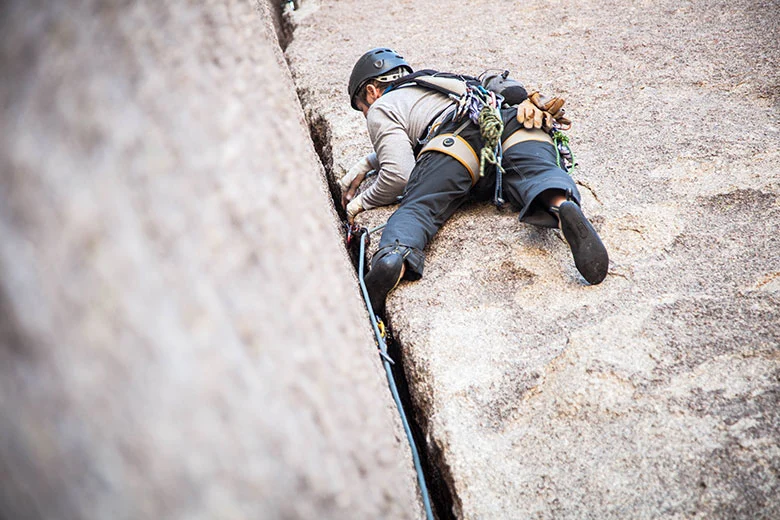
Essential trad climbing requires basic climbing gear like a harness, shoes, helmet, and belay device. In addition, you need anchor-building materials such as cams, nuts, hexes, tricams, and big bros to secure you during the climb and also slings, quickdraws, and carabiners to attach to the anchors. Read on to find out more about these various types of equipment,
Harness, Shoes, Helmet, And Belay Device
Here are some essential items that every beginner trad climber must possess:
1. Climbing Shoes: You will need a pair of tight-fitting and snug climbing shoes for precision footwork and grip on the rock surface.
2. Climbing Harness: A harness is worn around your waist and thighs, providing support and protection during climbs. It includes gear loops to hold protective equipment like cams, nuts, quickdraws, slings, and carabiners.
3. Helmet: It’s essential to wear a helmet to protect your head from falling rocks or equipment in case of a fall.
4. Belay Device: This device allows you to control the rope safely while belaying (securing another climber’s progress) or rappelling (descending from a climb).
There are several different types of belay devices available, including:
- ATCs (tubular belay devices)
- ADBs (Assisted Braking Device), such as the GriGri, which use a mechanical camming action to clamp the rope, and
- The Petzl Reverso which is a tubular-style belay device that can be used in “guide mode” to belay a second from above
Making sure you have the right gear is critical when starting with trad climbing. Ensure all your equipment fits well and is functional before climbing. Additionally, always double-check your gear placement before proceeding with any ascent.
Anchor Building Materials: Stoppers, Cams, Nuts, Hexes, Tricams, And Big Bros
Trad climbing requires a wide array of anchor building materials, including nuts, hexes, cams, Big Bros, and more, to ensure climbers stay safe. Here’s what you need to know about these essential tools:
1. Stoppers and Nuts are small pieces of metal that fit into vertical cracks in the rock to create an anchor. They come in a variety of sizes and shapes.
2. Hexes are hexagonal-shaped pieces which are bigger than nuts and can be used for larger cracks.
3. Cams are mechanical devices that expand inside cracks when they’re tightened down with a trigger mechanism. They provide excellent protection in parallel-sided cracks.
4. Tricams are hybrid pieces of gear that can be placed like nuts or camming devices, depending on how they’re rigged.
5. Big Bros are very large camming devices that work best in flared cracks where standard cams won’t fit.
Remember, using the right gear is essential for protecting yourself while trad climbing, so make sure you have plenty of options and know how to use them properly before you hit the rock face!
Other Essential Gear: Slings, Quickdraws, Carabiners
1. Climbing slings: Slings can be made of nylon or dyneema, and they are used to tie into anchors, build belay stations, and extend protection. It’s essential to have a range of sling lengths in your rack.
2. Quickdraws: These consist of two non-locking carabiners connected by a short length of webbing or tape. They’re used to clip the rope into protection as you climb. You’ll want several standard-length quickdraws and a few longer ones for routes with wandering lines.
3. Carabiners: These come in numerous shapes and sizes, but you’ll primarily use them for clipping into protection and anchoring yourself while climbing. Carabiners with locking gates are crucial for building belay anchors.
Remember that gear is only as good as its placement – it’s vital to learn how to place gear correctly before venturing out on your own.
Start by practicing placements on easier routes or with an experienced mentor, always double-check everything before moving on to the next piece of protection, and use specialized tools like nut tools to help remove stuck gear safely.
[convertkit form=5027836]
Trad Climbing Basics: Building Anchors, Leads and Seconds, and Rappelling
Check out this video to learn more about the Trad Climbing:
Building Trad Climbing Anchors
As a beginner trad climber, building anchors is one of the most important skills to master. Here are some essential tips for creating a strong and secure anchor:
1. Use at least two solid gear placements to build your anchor.
2. Equalize the load between all gear placements using slings or cords.
3. Use different types of gear, such as cams, nuts, and hexes, for redundancy in case one placement fails.
4. Make sure each gear placement is properly sized and wedged into place so it can’t pop out unexpectedly.
5. Use a sling or cord to extend the anchor away from the rock to reduce rope drag and prevent excessive force on the anchor.
6. Always clip your climbing rope through a locking carabiner attached to the anchor for added security.
By following these basic guidelines for building anchors, you’ll be well on your way to safely navigating trad climbing routes and enjoying all that this exciting sport has to offer.
Remember, practice makes perfect, so keep honing your skills and learning new techniques along the way.
Leads And Seconds In Trad Climbing
In trad climbing, the leader is responsible for setting the route and placing gear for protection. They tie into a rope that is stacked entirely on the ground and ascend up the rock face, clipping their protective gear to it as they go.
The second climber, also known as the follower or seconder, then follows up after them, removing all of this gear from the rock face.
To ensure safety during traditional climbs, both climbers must work together seamlessly; good communication is essential. Experienced lead climbers will take time before setting off to explain each placement while making sure their partner understands how they should follow efficiently – such as not pulling out too much protective gear and potentially damaging the rock surface.
Rappelling
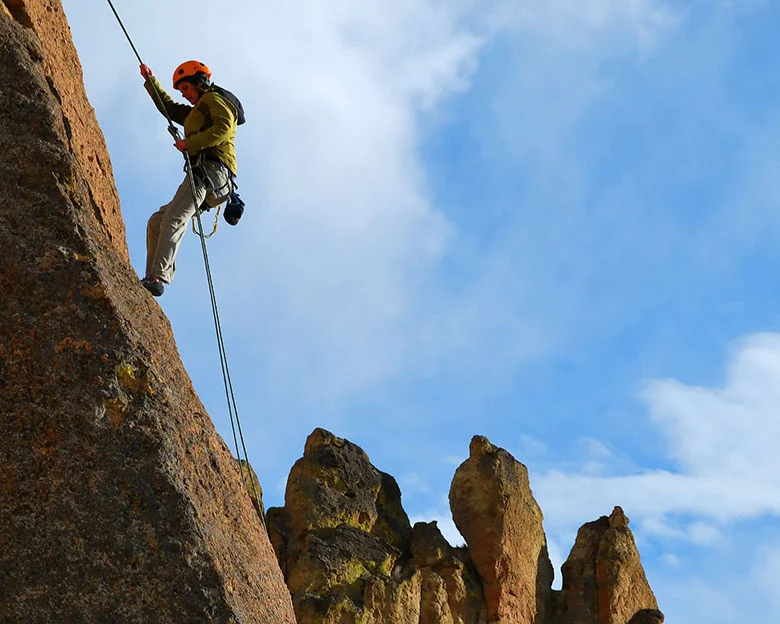
After a successful climb, it’s time to get back down safely. Trad climbers use a method called rappelling, which involves descending the rope while facing the rock face.
To set up for rappelling, you need to build an anchor at the top of the route using gear like cams and nuts. Then, you attach yourself to this anchor with slings or cordellettes and thread the rope through it.
Once you are securely anchored in place, you untie from your climbing rope and thread it through the rappel device, making sure to lock off properly before starting their descent.
Additional Items For Remote Climbing Regions
When climbing in remote regions, it’s important to be prepared with the right gear. Here are some additional items you may want to consider bringing:
1. Satellite phone or emergency beacon – In case of an emergency, having a way to communicate for help is crucial.
2. Portable stove and fuel – If you’ll be camping overnight, you’ll need a way to cook your meals.
3. Water filter or purification tablets – You can’t count on finding clean water sources in remote areas, so bring something to treat water if needed.
4. First aid kit – Always have a well-stocked first aid kit in case of injuries while climbing.
5. Headlamp – Climbing in low-light conditions is often necessary, especially if you’re starting early in the morning or finishing after sunset.
6. Warm clothing layers – Even if the weather appears mild during the day, temperatures can drop drastically at night in remote areas.
7. Extra food and water – It’s always better to have more food and water than you think you’ll need, just in case your climb takes longer than expected or unexpected delays occur.
Remember, when climbing in remote areas, safety should always come first. Be sure to inform someone back home of your planned route and expected return time before climbing.
Check out our comprehensive library of articles on Trad Climbing to learn more.
Embark on Your Trad Climbing Journey
In conclusion, trad climbing is an exhilarating and challenging form of rock climbing that requires skill, practice, and the right gear. It’s crucial for beginners to learn basic climbing skills, understand different types of protective equipment, and master techniques for building anchors.
While it can be dangerous if not done safely, with proper training from a certified guide or mentor, anyone can successfully learn how to trad climb. Remember to always prioritize safety. Always invest in high-quality gear and know how to properly use and maintain it.

